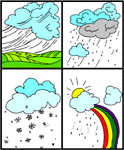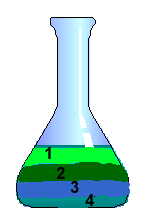|
|
1. Four liquids were poured in a beaker. The layered as
in the diagram below. Which layer is the most dense?
2. You can see at the bottom of the oceans:
3. The two elements that make up water are:
4. If you pour salad oil on water it will float. Why does this happen?
5. Air pollution is caused by:
6. The clouds are puffy and white. It looks like:
7. The clouds are dark and puffy. It looks like:
8. Cirrus clouds refers to clouds that are:
9. Weather usually occurs in the:
10. The higher you go in the atmosphere the:
11. The most abundant gas in the lower part of our atmosphere is:
12. The San Francisco Estuarine System is made of three bays. Which of the following is not part of this system?
13. Draw the direction of the water cycle. Include in your diagram the following: precipitation, evaporation, condensation, rivers, lakes, and groundwater.
ANSWERS: 1.(A); 2.(D); 3.(A); 4.(B); 5.(A); 6.(B); 7.(A); 8.(C); 9.(A); 10.(C); 11.(D); 12.(C) |

 Water
Cycle
Water
Cycle  A. 4
A. 4